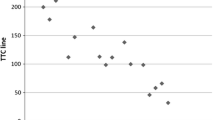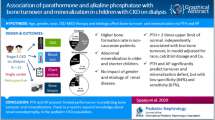Abstract
Several new serum markers for bone metabolism have recently become available and are being applied to clinical practice. Their clinical usefulness in predialysis patients with chronic renal failure (CRF), however, has not yet been determined. Serum levels of three bone formation markers—bone alkaline phosphatase (BAP), osteocalcin (OC), and N-terminal propeptide of type I collagen (PINP)—and three bone resorption markers—type I collagen cross-linked N-telopeptide (NTx), deoxypyridinoline (DPD), and pyridinoline (PYD)—were measured simultaneously in 85 predialysis CRF patients (serum creatinine 3.5 ± 1.9 mg/dl, 61.0 ± 10.9 years old, 54 males and 31 females, 36 diabetics and 49 nondiabetics) to examine the relationships between these markers and bone mineral density (BMD) of the distal radius, as measured by peripheral quantitative computed tomography (pQCT). Trabecular BMD, which is strongly affected by bone metabolism, was significantly negatively correlated with each of the bone formation markers (r=−0.341, p=0.0016, for OC; r=−0.314, p=0.0036, for PINP; r=−0.238, p=0.0315, for BAP), but there was no significant correlation between BMD and any of the bone resorption markers. In multivariate regression analyses (adjusted by age, sex, presence of diabetes, glomerular filtration rate, intact parathyroid hormone, calcium, phosphate, and 1,25-dihydroxyvitamin D), OC and PINP were significantly associated with a decrease in BMD, but BAP was not. In conclusion, we demonstrated that in predialysis CRF patients, BMD of the distal radius, particularly of trabecular bone, is associated with serum OC and PINP levels. OC and PINP are suggested to be possible parameters for the clinical evaluation of the effect of bone metabolism on BMD.
Similar content being viewed by others
References
Elder G (2002) Pathophysiology and recent advances in the management of renal osteodystrophy. J Bone Miner Res 17:2094–2105
Parfitt AM (1998) A structural approach to renal bone disease. J Bone Miner Res 13:1213–1220
Ho LT, Sprague SM (2002) Renal osteodystrophy in chronic renal failure. Semin Nephrol 22:488–493
Slatopolsky E, Gonzalez E, Martin K (2003) Pathogenesis and treatment of renal osteodystrophy. Blood Purif 21:318–326
Mazzaferro S, Coen G, Ballanti P, Bondatti F, Bonucci E, Pasquali M, Sardella D, Tomei E, Taggi F (1990) Osteocalcin, iPTH, alkaline phosphatase and hand X-ray scores as predictive indices of histomorphometric parameters in renal osteodystrophy. Nephron 56:261–266
Rix M, Andreassen H, Eskildsen P, Langdahl B, Olgaard K (1999) Bone mineral density and biochemical markers of bone turnover in patients with predialysis chronic renal failure. Kidney Int 56:1084–1093
Hernandez D, Concepcion MT, Lorenzo V, Martinez ME, Rodriguez A, De Bonis E, Gonzalez-Posada JM, Felsenfeld AJ, Rodriguez M, Torres A (1994) Adynamic bone disease with negative aluminium staining in predialysis patients: prevalence and evolution after maintenance dialysis. Nephrol Dial Transplant 9:517–523
Przedlacki J, Manelius J, Huttunen K (1995) Bone mineral density evaluated by dual-energy X-ray absorptiometry after one-year treatment with calcitriol started in the predialysis phase of chronic renal failure. Nephron 69:433–437
Bervoets AR, Spasovski GB, Behets GJ, Dams G, Polenakovic MH, Zafirovska K, Van Hoof VO, De Broe ME, D’Haese PC (2003) Useful biochemical markers for diagnosing renal osteodystrophy in predialysis end-stage renal failure patients. Am J Kidney Dis 41:997–1007
Fogelman I, Blake GM (2000) Different approaches to bone densitometry. J Nucl Med 41:2015–2025
Looker AC, Bauer DC, Chesnut CH 3rd, Gundberg CM, Hochberg MC, Klee G, Kleerekoper M, Watts NB, Bell NH (2000) Clinical use of biochemical markers of bone remodeling: current status and future directions. Osteoporos Int 11:467–480
Gorai I, Nonaka K, Kishimoto H, Sakata H, Fujii Y, Fujita T (2001) Cut-off values determined for vertebral fracture by peripheral quantitative computed tomography in Japanese women. Osteoporos Int 12:741–748
Lochmuller EM, Muller R, Kuhn V, Lill CA, Eckstein F (2003) Can novel clinical densitometric techniques replace or improve DXA in predicting bone strength in osteoporosis at the hip and other skeletal sites? J Bone Miner Res 18:906–912
Watts NB (1999) Clinical utility of biochemical markers of bone remodeling. Clin Chem 45:1359–1368
Coen G, Ballanti P, Bonucci E, Calabria S, Centorrino M, Fassino V, Manni M, Mantella D, Mazzaferro S, Napoletano I, Sardella D, Taggi F (1998) Bone markers in the diagnosis of low turnover osteodystrophy in haemodialysis patients. Nephrol Dial Transplant 13:2294–2302
Couttenye MM, D’Haese PC, Van Hoof VO, Lemoniatou E, Goodman W, Verpooten GA, De Broe ME (1996) Low serum levels of alkaline phosphatase of bone origin: a good marker of adynamic bone disease in haemodialysis patients. Nephrol Dial Transplant 11:1065–1072
Ueda M, Inaba M, Okuno S, Nagasue K, Kitatani K, Ishimura E, Shimizu M, Miki T, Kim M, Nishizawa Y (2002) Clinical usefulness of the serum N-terminal propeptide of type I collagen as a marker of bone formation in hemodialysis patients. Am J Kidney Dis 40:802–809
Ferreira MA (2000) Diagnosis of renal osteodystrophy: when and how to use biochemical markers and non-invasive methods; when bone biopsy is needed. Nephrol Dial Transplant 15[Suppl 5]:8–14
Ha SK, Park CH, Seo JK, Park SH, Kang SW, Choi KH, Lee HY, Han DS (1996) Studies on bone markers and bone mineral density in patients with chronic renal failure. Yonsei Med J 37:350–356
Ishimura E, Nishizawa Y, Inaba M, Matsumoto N, Emoto M, Kawagishi T, Shoji S, Okuno S, Kim M, Miki T, Morii H (1999) Serum levels of 1,25-dihydroxyvitamin D, 24,25-dihydroxyvitamin D, and 25-hydroxyvitamin D in nondialyzed patients with chronic renal failure. Kidney Int 55:1019–1027
Lepage R, Roy L, Brossard JH, Rousseau L, Dorais C, Lazure C, D’Amour P (1998) A non-(1-84) circulating parathyroid hormone (PTH) fragment interferes significantly with intact PTH commercial assay measurements in uremic samples. Clin Chem 44:805–809
Fraser WD, Durham BH, Berry JL, Mawer EB (1997) Measurement of plasma 1,25 dihydroxyvitamin D using a novel immunoextraction technique and immunoassay with iodine labelled vitamin D tracer. Ann Clin Biochem 34 ( Pt 6):632–637
Levey AS, Bosch JP, Lewis JB, Greene T, Rogers N, Roth D (1999) A more accurate method to estimate glomerular filtration rate from serum creatinine: a new prediction equation. Modification of Diet in Renal Disease Study Group. Ann Intern Med 130:461–470
Shibuya K, Hagino H, Morio Y, Teshima R (2002) Cross-sectional and longitudinal study of osteoporosis in patients with rheumatoid arthritis. Clin Rheumatol 21:150–158
Lochmuller EM, Lill CA, Kuhn V, Schneider E, Eckstein F (2002) Radius bone strength in bending, compression, and falling and its correlation with clinical densitometry at multiple sites. J Bone Miner Res 17:1629–1638
Tsurusaki K, Ito M, Hayashi K (2000) Differential effects of menopause and metabolic disease on trabecular and cortical bone assessed by peripheral quantitative computed tomography (pQCT). Br J Radiol 73:14–22
Ashizawa N, Nonaka K, Michikami S, Mizuki T, Amagai H, Tokuyama K, Suzuki M (1999) Tomographical description of tennis-loaded radius: reciprocal relation between bone size and volumetric BMD. J Appl Physiol 86:1347–1351
Gomez B Jr, Ardakani S, Ju J, Jenkins D, Cerelli MJ, Daniloff GY, Kung VT (1995) Monoclonal antibody assay for measuring bone-specific alkaline phosphatase activity in serum. Clin Chem 41:1560–1566
Kumeda Y, Inaba M, Tahara H, Kurioka Y, Ishikawa T, Morii H, Nishizawa Y (2000) Persistent increase in bone turnover in Graves’ patients with subclinical hyperthyroidism. J Clin Endocrinol Metab 85:4157–4161
Inaba M, Nishizawa Y, Mita K, Kumeda Y, Emoto M, Kawagishi T, Ishimura E, Nakatsuka K, Shioi A, Morii H (1999) Poor glycemic control impairs the response of biochemical parameters of bone formation and resorption to exogenous 1,25-dihydroxyvitamin D3 in patients with type 2 diabetes. Osteoporos Int 9:525–531
Takahashi M, Kushida K, Nagano A, Inoue T (2000) Comparison of the analytical and clinical performance characteristics of an N-MID versus an intact osteocalcin immunoradiometric assay. Clin Chim Acta 294:67–76
Tahtela R, Turpeinen M, Sorva R, Karonen SL (1997) The aminoterminal propeptide of type I procollagen: evaluation of a commercial radioimmunoassay kit and values in healthy subjects. Clin Biochem 30:35–40
Furumitsu Y, Inaba M, Yukioka K, Yukioka M, Kumeda Y, Azuma Y, Ohta T, Ochi T, Nishizawa Y, Morii H (2000) Levels of serum and synovial fluid pyridinium crosslinks in patients with rheumatoid arthritis. J Rheumatol 27:64–70
Nemoto R, Nakamura I, Nishijima Y, Shiobara K, Shimizu M, Takehara T, Ohta T, Kiyoki M (1997) Serum pyridinoline crosslinks as markers of tumour-induced bone resorption. Br J Urol 80:274–280
Niwa T, Shiobara K, Hamada T, Miyazaki T, Tsukushi S, Uema K, Tsuzuki T (1995) Serum pyridinolines as specific markers of bone resorption in hemodialyzed patients. Clin Chim Acta 235:33–40
Montagnani A, Gonnelli S, Cepollaro C, Mangeri M, Martini S, Franci MB, Campagna MS, Lucani B, Di Paolo N, Bellucci G, Gennari C (2003) A new serum assay to measure N-terminal fragment of telopeptide of type I collagen in patients with renal osteodystrophy. Eur J Intern Med 14:172–177
Hutchison AJ, Whitehouse RW, Boulton HF, Adams JE, Mawer EB, Freemont TJ, Gokal R (1993) Correlation of bone histology with parathyroid hormone, vitamin D3, and radiology in end-stage renal disease. Kidney Int 44:1071–1077
Coen G, Mazzaferro S, Ballanti P, Sardella D, Chicca S, Manni M, Bonucci E, Taggi F (1996) Renal bone disease in 76 patients with varying degrees of predialysis chronic renal failure: a cross-sectional study. Nephrol Dial Transplant 11:813–819
Muller ME, Webber CE, Bouxsein ML (2003) Predicting the failure load of the distal radius. Osteoporos Int 14:345–352
Urena P, De Vernejoul MC (1999) Circulating biochemical markers of bone remodeling in uremic patients. Kidney Int 55:2141–2156
Giangregorio L, Blimkie CJ (2002) Skeletal adaptations to alterations in weight-bearing activity: a comparison of models of disuse osteoporosis. Sports Med 32:459–476
Iwasaki Y, Yamato H, Murayama H, Sato M, Takahashi T, Ezawa I, Kurokawa K, Fukagawa M (2002) Maintenance of trabecular structure and bone volume by vitamin K(2) in mature rats with long-term tail suspension. J Bone Miner Metab 20:216–222
Liu G, Peacock M (1998) Age-related changes in serum undercarboxylated osteocalcin and its relationships with bone density, bone quality, and hip fracture. Calcif Tissue Int 62:286–289
Ross PD, Knowlton W (1998) Rapid bone loss is associated with increased levels of biochemical markers. J Bone Miner Res 13:297–302
Cheng S, Suominen H, Vaananen K, Kakonen SM, Pettersson K, Heikkinen E (2002) Serum osteocalcin in relation to calcaneal bone mineral density in elderly men and women: a 5-year follow-up. J Bone Miner Metab 20:49–56
Author information
Authors and Affiliations
Corresponding author
Rights and permissions
About this article
Cite this article
Tsuchida, T., Ishimura, E., Miki, T. et al. The clinical significance of serum osteocalcin and N-terminal propeptide of type I collagen in predialysis patients with chronic renal failure. Osteoporos Int 16, 172–179 (2005). https://doi.org/10.1007/s00198-004-1655-9
Received:
Accepted:
Published:
Issue Date:
DOI: https://doi.org/10.1007/s00198-004-1655-9




